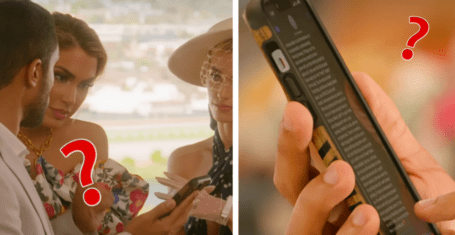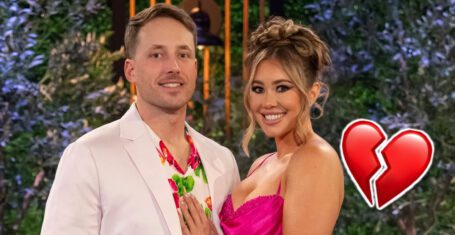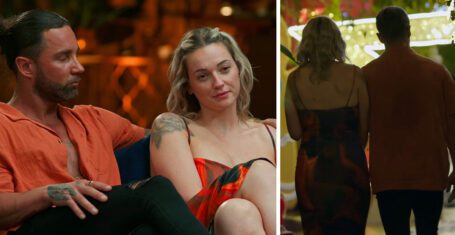
Inside No. 9 episode two ending explained: So, who the hell is Mr. King?
And why can’t I stop saying ‘human beans’?
Contains spoilers for Inside No. 9 series seven.
Basically, you’re either team “this episode is exactly like The Wicker Man!” or “this episode is exactly like Midsommar!” and there’s no in-between. As someone who’s seen neither, episode two of Inside No. 9 series seven is a standalone masterclass in small-town creepiness.
Mr. King is as puzzling as the “man” himself, in classic Pemberton/Shearsmith style. Just when you think the episode is about to take a dark, sinister turn; it 180s and takes another. Then another. In the end, you wind up sitting on your sofa with your jaw dropped, wondering what the hell you just watched for the last 30 minutes.
So, let’s take a deep-dive into Mr. King – what actually happened in the episode? And what in god’s name was that ending all about?
Here’s every single plot twist that happened in half an hour (!!!)
The episode opens on a primary school classroom, somewhere in rural Wales. Mr Edwards (Pemberton) – the headteacher – is introducing new class teacher Mr Curtis (Shearsmith) to the kids. Curtis begins his first lesson by enthusiastically teaching his children about global warming – a subject the villagers clearly know little about.
It soon becomes obvious that Curtis may be trying to radicalise the kids on climate change. He staples posters of Greta Thunberg around the room, assigns them homework to research the subject and tells one of his students – the quiet Kerry – to channel her fear into anger, just like Extinction Rebellion.

Photo via BBC
We’re then led down the garden path once again when Edwards confronts Curtis in his classroom. His tone is dark, and his attitude towards mental health is typical of an old village resident with “traditional” values. “I know it’s important to talk sensitively about mental health,” the headteacher says. “So I just wanted to clarify… you went a bit doolally, didn’t you?”
He then has the grim duty of informing Curtis that “an allegation” had been made against him by Kerry; the little girl he kept in at playtime to talk to about her affinity for slipping live tadpoles into teacher’s tea. Instead of going to the police, though, Edwards is keen to deal with things “independently” – and he does so by taking a Polaroid of Curtis’… erm, special area.
“The girl has given quite a vivid description,” Edwards says. “I need to see if this tallies with the real thing.” Yikes.

Photo via BBC
After sneaking into the staffroom to look at Mr. King’s file, Curtis finds a hoard of inappropriate photos buried in a folder. Each explicit image is implied to belong to every male teacher who came before Mr Curtis. He quickly discovers Mr. King isn’t a real person at all, but a smokescreen for “abuse,” and runs to report Edwards and everyone else complicit.
As he reaches the safety of his classroom, Curtis is told to sit down by the kids, who want to show him their class assembly on climate change. It begins innocently enough, with some jokes about recycling and unprecedented plastic swords. Attempting to get up from his chair, the teacher realises his arms have been superglued to the sides.

Photo via BBC
The kids then start to explain how “in the beginning, the Earth garden was the one who expressed herself… all souls were born from her sacred womb, lived for a span upon her body, the Earth and returned to her tomb womb at death.” They talk about sacrificing people to prevent natural disasters, before supergluing Curtis’ lips together and explaining how they’re going to “recycle” him.
Edwards tells Curtis he’s about to become the harvest king – Mr. King, if you will. The photos he took were to make sure the teacher was “as nature intended” (double yikes). They take him away for his honourable “triple death” – I’ll leave that one to your imaginations.
Wait, so… why did they kill Mr Curtis?

Photo via BBC
For centuries, stories have been shared about village cults sacrificing people to save the Earth.
John Barleycorn – the harvest king – is an English folklore legend. A book called The Golden Bough told the story of a Pagan cult who sacrificed Barleycorn to bring fertility to the fields.
A character named Neil Howie is sacrificed to save the failing crops in 1973 film The Wickerman (49-year-old spoiler, I guess).
Ultimately, it’s just another scary story about small villagers killing big-city people for the good of their land. It’s all mythical and none of it makes any sense. But, it somehow works every time.
Related stories recommended by this writer:
- Inside No. 9: Merrily, Merrily ending explained
- Here’s the confirmed cast of Inside No. 9 as it returns for series seven
- Every single way Netflix changed Heartstopper from the original novel
Featured image via BBC.





















